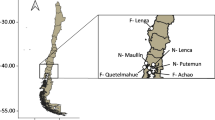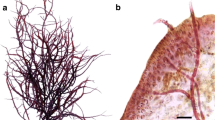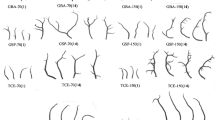Abstract
Colaconema daviesii, a filamentous red alga, has been previously reported as an endophyte infesting Chondracanthus chamissoi. This study focuses on identifying the symptoms of C. daviesii infesting on haploid and diploid thalli of C. chamissoi. Co-cultivation of C. daviesii with diploid and haploid thalli of C. chamissoi was conducted under two treatments. Treatment 1 was under a 12:12 h (L:D) photoperiod for 40 days. Treatment 2 was under a 12:12 h (L:D) photoperiod for 20 days, followed by a 16:08 h (L:D) photoperiod for an additional 20 days. Parameters such as the density and coverage of C. daviesii filaments on C. chamissoi thalli were measured, as well as the growth rate and survival of C. chamissoi. Infestation occurred in both treatments and phases, with an increase in the presence of C. daviesii as the photoperiod extended. This relationship negatively affected the host in all measured parameters, with the diploid phase being more adversely affected. Infestation begins with spores under a 12:12 h (L:D) photoperiod condition, and filament development is observed on C. chamissoi thalli as the photoperiod increases. Early infestation symptoms were not evident, complicating the recognition of C. daviesii on haploid and diploid thalli of C chamissoi. The potential risk of transferring C. chamissoi contained filaments of C. daviesii through cultivation is postulated.









Similar content being viewed by others
Data availability
The data that supports the results of the present research study are available when solicited to the corresponding author.
References
Araújo PG, Schmidt ÉC, Kreusch MG, Kano CH, Guimarães SMPB, Bouzon ZL, Fujii MT, Yokoya NS (2014) Ultrastructural, morphological, and molecular characterization of Colaconema infestans (Colaconematales, Rhodophyta) and its host Kappaphycus alvarezii (Gigartinales, Rhodophyta) cultivated in the Brazilian tropical region. J Appl Phycol 26:1953–1961
Arbaiza S, Avila-Peltroche J, Castañeda-Franco M, Mires-Reyes A, Advíncula O, Baltazar P (2023) Vegetative propagation of the commercial red seaweed Chondracanthus chamissoi in Peru by secondary attachment disc during indoor cultivation. Plants 12:1940
Avila-Peltroche J, Padilla-Vallejos J (2020) The seaweed resources of Peru. Bot Mar 63:381–394
Avila-Peltroche J, Villena-Sarmiento G (2022) Analysis of Peruvian seaweed exports during the period 1995–2020 using trade data. Bot Mar 65:209–220
Basaure H, Macchiavello J, Sepúlveda C, Sáez F, Yañez D, Vega L, Marín C (2021) Sea bottom culture of Chondracanthus chamissoi (Rhodophyta: Gigartinales) by vegetative propagation at Puerto Aldea, Tongoy Bay (Northern Chile). Aquac Res 52:2025–2035
Behera DP, Ingle KN, Mathew DE, Dhimmar A, Sahastrabudhe H, Sahu SK, Krishnan MG, Shinde PB, Ganesan M, Mantri VA (2022) Epiphytism, diseases and grazing in seaweed aquaculture: A comprehensive review. Rev Aquac 14:1345–1370
Bouarab K, Potin P, Weinberger F, Correa J, Kloareg B (2001) The Chondrus crispus-Acrochaete operculata host-pathogen association, a novel model in glycobiology and applied phycopathology. J Appl Phycol 13:185–193
Bulboa CR, Macchiavello JE (2001) The effects of light and temperature on different phases of the life cycle in the carrageenan producing alga Chondracanthus chamissoi (Rhodophyta, Gigartinales). Bot Mar 44:371-374
Bulboa CR, Macchiavello JE (2006) Cultivation of cystocarpic, tetrasporic and vegetative fronds of Chondracanthus chamissoi (Rhodophyta, Gigartinales) on ropes at two localities in northern Chile. Invest Mar 34:109–112.
Bulboa CR, Macchiavello JE, Oliveira EC, Fonck E (2005) First attempt to cultivate the carrageenan-producing seaweeds Chondracanthus chamissoi (C. Agardh) Kützing (Rhodophyta; Gigartinales) in Northern Chile. Aquac Res 36:1069–1074
Bulboa C, Macchiavello J, Oliveira E, Véliz K (2008) Growth rate differences between four Chilean populations of edible seaweed Chondracanthus chamissoi (Rhodophyta, Gigartinales). Aquac Res 39:1550–1555
Bulboa C, Macchiavello J, Véliz K, Oliveira EC (2010) Germination rate and sporeling development of Chondracanthus chamissoi (Rhodophyta, Gigartinales) varies along a latitudinal gradient on the coast of Chile. Aquat Bot 92:137–141
Bulboa C, Véliz K, Sáez F, Sepúlveda C, Vega L, Macchiavello J (2013) A new method for cultivation of the carragenophyte and edible red seaweed Chondracanthus chamissoi based on secondary attachment disc: Development in outdoor tanks. Aquaculture 410:86–94
Bulboa C, Massad I, Contreras-Porcia L, Zapata J, Castañeda F, Ramírez M, Gil-Kodaka P (2020) Concise review of genus Chondracanthus (Rhodophyta: Gigartinales). J Appl Phycol 32:773–785
Correa J (1990) Pigmented algal endophytes of Chondrus crispus Stackhouse: host-specificity, fine structure and effects on host performance in infections by Acrochaete operculata Correa & Nielsen and A. heteroclada Correa & Nielsen. PhD Dissertation, Dalhousie University, Canada.
Correa JA, McLachlan JL (1993) Endophytic algae of Chondrus crispus (Rhodophyta). V. Fine structure of the infection by Acrochaete operculata (Chlorophyta). Eur J Phycol 29:33–47
Correa JA, Nielsen R, Grund DW (1988) Endophytic algae of Chondrus crispus (Rhodophyta). II. Acrochaete heteroclada sp. nov., A. operculata sp. nov, and Pharophila dendroides (Chorophyta). J Phycol 24:528–539
Etcheverry H (1986) Algas marinas bentónicas de Chile. UNESCO, Chile
Friedlander M, Gonen Y, Kashman Y, Beer S (1996) Gracilaria conferta and its epiphytes: 3. Allelopathic inhibition of the red seaweed by Ulva cf. lactuca. J Appl Phycol 8:21–25
García-Redondo V, Bárbara I, Díaz-Tapia P (2019) Biodiversity of epiphytic macroalgae (Chlorophyta, Ochrophyta, and Rhodophyta) on leaves of Zostera marina in the northwestern Iberian Peninsula. Anales Jard Bot Madrid 76:e078
Gauna MC, Parodi E (2008) Green epiphyte in Hymenena falklandica (Rhodophyta) from the Patagonia coasts of Argentina: preliminary observations. Phycol Res 56:172–182
González J, Meneses I, Vásquez J (1997) Field studies in Chondracanthus chamissoi (C. Agardh) Kützing: seasonal and spatial variations in life-cycle phases. Biol Pesq 26:3–12
Hansen GI, Hanyuda T, Kawai, H (2017) Benthic marine algae on Japanese tsunami marine debris: a morphological documentation of the species. Part 1. The tsunami event, the project overview, and the red algae. OSU Scholars Archive, Corvallis.
Hayashi L, Bulboa C, Kradolfer P, Soriano G, Robledo D (2014) Cultivation of red seaweeds: A Latin American perspective. J Appl Phycol 26:719–727
Ingle KN, Polikovsky M, Chemodanov A, Golberg A (2018) Marine integrated pest management (MIPM) approach for sustainable seagriculture. Algal Res 29:223–232
Katsaros C, Orfanidis S, Küpper FC (2022) What’s new in marine botany of the Eastern Mediterranean? Bot Mar 65:221–230.
Kim C, Kim YS, Choi HG, Nam KW (2014) New records of three endophytic green algae from Grateloupia spp. (Rhodophyta) in Korea. Algae 29:127–136
Lee M-C, Yeh H-Y (2021) Molecular and morphological characterization of Colaconema formosanum sp. nov. (Colaconemataceae, Rhodophyta): A new endophytic filamentous red algal species from Taiwan. J Mar Sci Eng 9:809.
Lein TE, Sjøtun K, Wakili S (1991) Mass-occurrence of a brown filamentous endophyte in the lamina of the kelp Laminaria hyperborea (Gunnerus) Foslie along the southwestern coast of Norway. Sarsia 76:187–193
Leonardi PI, Miravalles AB, Faugeron S, Flores V, Beltrán J, Correa JA (2006) Diversity, phenomenology, and epidemiology of epiphytism in farmed Gracilaria chilensis (Rhodophyta) in northern Chile. Eur J Phycol 41:247–257
López B (2017) Micropropagación y cultivo de la “Mota Lisa”, un morfotipo de Chondracanthus chamissoi (C. Agardth) Kützing (Rhodophyta; Gigartinales). Dissertation. Universidad Andrés Bello, Chile.
Macchiavello J, Sepúlveda C, Basaure H, Sáez F, Yañez D, Marín C, Vega L (2018) Suspended culture of Chondracanthus chamissoi (Rhodophyta: Gigartinales) in Caleta Hornos (northern Chile) via vegetative propagation with secondary attachment discs. J Appl Phycol 30:1149–1155
Méndez C, Bustamante DE, Calderon MS, Gauna C, Hayashi L, Robledo D, Tapia-Larios C, Campbell I, Westermeier R, Murúa P (2024) Biosecurity baseline for a sustainable development of seaweed aquaculture in Latin America. Mar Policy 159:105933
Montoya V (2019) Colaconema daviesii (Rhodophyta; Colaconematales) una endófita del alga comercial Chondracanthus chamissoi. Dissertation, Universidad Andrés Bello, Chile.
Montoya V, Meynard A, Contreras-Porcia L, Contador CB (2020) Molecular identification, growth, and reproduction of Colaconema daviesii (Rhodophyta; Colaconematales) endophyte of the edible red seaweed Chondracanthus chamissoi. J Appl Phycol 32:3533–3542
Murúa P, Garvetto A, Egan S, Gachon CMM (2023) The reemergence of phycopathology: When algal biology meets ecology and biosecurity. Annu Rev Phytopathol 61:231–255
Ogandaga CAM, Choil HG, Jang JK, Nam KW (2016) Growth responses of Chondrus ocellatus Holmes (Gigartinales, Rhodophyta) two endophyte, Mikrosyphar zostera Kuckuck (Ectocarpales, Ochrophyta), and Ulvella ramosa (N. L Gardner) R. Nielsen (Ulvales, Chlorophyta) in culture. Algae 31:363–371
Oyarzo S, Ávila M, Alvear P, Remonsellez JP, Contreras-Porcia L, Bulboa C (2021) Secondary attachment disc of edible seaweed Chondracanthus chamissoi (Rhodophyta, Gigartinales): Establishment of permanent thalli stock. Aquaculture 530:735954
Poza AM, Gauna MC, Escobar JF, Parodi ER (2018) Temporal dynamics of algal epiphytes on Leathesia marina and Colpomenia sinuosa macrothalli (Phaeophyceae). Mar Biol Res 4:65–75
Ramírez C, Bulboa C, Contreras L, Mora AM (2018) Flora Marina Bentónica de Quintay. Ril Editores, Chile
RStudio Team (2020) Integrated development for R. RStudio, PBC, Boston. http://www.rstudio.com/
Schneider CA, Rasband WS, Eliceiri KW (2012) NIH Image to ImageJ: 25 years of image analysis. Nature Meth 9:671–675
Thornber CS (2006) Functional properties of the isomorphic biphasic algal life cycle. Integr Comp Biol 46:605–614
Usandizaga S, Beltrán J, Faugeron S, Camus C (2023) Contrasting response of Gracilaria chilensis (Gracilariales, Rhodophyta) life cycle stages to epiphyte infection. J Appl Phycol 35:1831–1845
Vásquez JA, Vega JMA (2001) Chondracanthus chamissoi (Rhodophyta, Gigartinales) in northern Chile: ecological aspects for management of wild populations. J Appl Phycol 13:267–277
Vieira VMNCS, Engelen AH, Huanel OR, Guillemin M-L (2021) Differential frond growth in the isomorphic haploid–diploid red seaweed Agarophyton chilense by long-term in situ monitoring. J Appl Phycol 57:592–605
Ward GM, Faisan JP Jr, Cottier-Cook EJ, Gachon C, Hurtado AQ, Lim PE, Matoju I, Msuya FE, Bass D, Brodie J (2020) A review of reported seaweed diseases and pests in aquaculture in Asia. J World Aquac Soc 51:815–828
Weinberger F, Hoppe H-G, Friedlander M (1997) Bacterial induction and inhibition of a fast necrotic response in Gracilaria conferta (Rhodophyta). J Appl Phycol 9:277–285
Weinberger F, Pohnert G, Kloareg B, Potin P (2002) A signal released by an endophytic attacker acts as a substrate for a rapid defensive reaction of the red alga Chondrus crispus. ChemBioChem 29:69–76
Wynne M, Schneider C (2008) Colaconema basiramosum sp. nov. (Colaconemataceae, Rhodophyta) from the Sultanate of Oman, northern Arabian Sea. Cryptogam Algol 29:69–76
Yang MY, Macaya EC, Kim MS (2015) Molecular evidence for verifying the distribution of Chondracanthus chamissoi and C. teedei (Gigartinaceae, Rhodophyta). Bot Mar 58:103–113.
Yong YS, Yong WTL, Anton A (2013) Analysis of formulae for determination of seaweed growth rate. J Appl Phycol 25:1831–1834
Acknowledgments
We extend our gratitude to LEPAM (Laboratory of Studies and Production of Marine Algae), where the present work was conducted. We also acknowledge CIDTA (Center for Research and Technological Development in Algae and Other Biological Resources) for their assistance in the collection of C. chamissoi. Finally, we appreciate the support from CIMARQ (Center for Marine Research), where the cultivation of both C. chamissoi and C. daviesii was carried out. We also thank two anonymous reviewers for their comments.
Funding
The authors did not receive support from any organization for the submitted work
Author information
Authors and Affiliations
Contributions
Valentina Montoya: conceptualization, investigation, visualization, Software, writing – original draft, Methodology. Paula Alvear: conceptualization, investigation, methodology. Cristian Bulboa: Conceptualization, Supervision, writing – review & editing.
Corresponding author
Ethics declarations
Competing interests
The authors declare that they have no known competing financial interests or personal relationships that could have appeared to influence the work reported in this paper.
Additional information
Publisher's Note
Springer Nature remains neutral with regard to jurisdictional claims in published maps and institutional affiliations.
Rights and permissions
Springer Nature or its licensor (e.g. a society or other partner) holds exclusive rights to this article under a publishing agreement with the author(s) or other rightsholder(s); author self-archiving of the accepted manuscript version of this article is solely governed by the terms of such publishing agreement and applicable law.
About this article
Cite this article
Montoya, V., Alvear, P. & Bulboa, C. Infestation by Colaconema daviesii (Rhodophyta, Colaconematales) of haploid and diploid thalli of edible red seaweed Chondracanthus chamissoi (Rhodophyta, Gigartinales): effects on growth and survival. J Appl Phycol (2024). https://doi.org/10.1007/s10811-024-03215-z
Received:
Revised:
Accepted:
Published:
DOI: https://doi.org/10.1007/s10811-024-03215-z




